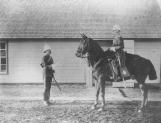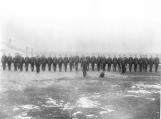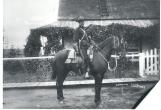14
Sergeant-Major Sam Steele recalls the duties of the commanding officers when Griesbach arrives at Fort Saskatchewan:"Superintendent Jarvis was left in command after Colonel Smith returned to Winnipeg. Inspector Walsh took over the duties of adjutant, veterinary surgeon and riding master. Griesbach took charge of the discipline and instructed the divisions at foot drill in the square of the fort. I took over the breaking of the horses and instructed the NCO's and men in riding."
15
James Mowat to the rescue!17
In 1885, news and fear of the second uprising of the Métis at Batoche resulted in a need for extra troops to be sent to Fort Saskatchewan. A meeting was held and it was decided that a rider would be sent to Calgary with a message requesting additional force to protect the Fort Headquarters and its area settlers.Unfortunately, there was no money to hire a messenger. A resident settler of the Fort, James Mowat, realized the severity of the situation and volunteered his service. That evening he rode to Calgary in full gallop for 2 days, reaching his destination of 220 miles in an incredible 36 hours!
James became the local hero as delivering this message was instrumental for the deployment of extra recruits to the area. For his return, he took a well-needed six days.
19
Excellent horsemanship and marksmanship were paramount for the success of the police patrols in the North West Territories. Griesbach ensured that the troops received proper instruction when preparing for the deployment and peace keeping mission of the Red River Rebellion uprising.Further, with the change of Division stature, Inspector Griesbach received a promotion in rank to Superintendent and undertook the training and subsequent command of an additional 100 recruits for combat during the Riel Rebellion of 1885.
The increase in recruits caused discontent among the men as the conditions of the barracks were not suitable for the corps size. Again there was a discussion that involved relocating the Police Headquarters to Edmonton.
In the end, the Fort on the Saskatchewan remained as the police headquarters with substantial improvements implemented to accommodate the growth of the troop.
20
A Farrier's Job22
Being Farrier for the North West Mounted Police force was a most demanding position in the corps and required a man with extensive knowledge of horses. If there was a Veterinarian Surgeon posted at the barracks, the Farrier assisted him with the implementation of a proper foot care program.Quarter-Master Sergeant Emery was such an individual and exerted meticulous and daily care for the horses of "G" troop. He knew that keeping a regimental process would make or break the mount. Emery kept a close eye on the horses making sure their home at the barracks, their preparation for travel while on patrol and their nutrition was sufficient for their role in the force. A horse is only as good as its hooves!


